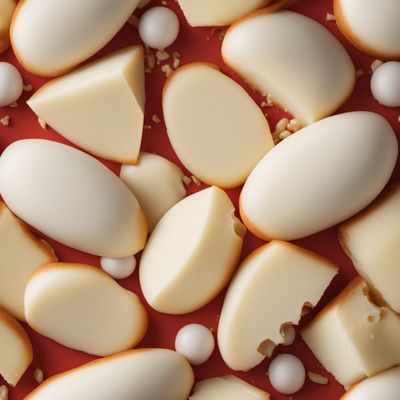
Ingredient
Cheese, morski
The Oceanic Delight: Exploring the Unique Flavors of Morski Cheese
Morski cheese is a semi-hard cheese with a pale yellow color and a slightly crumbly texture. It is made from cow's milk and has a rich, creamy taste with a hint of saltiness. The cheese has small irregular holes throughout, adding to its character. Its smooth and velvety mouthfeel makes it a delightful addition to both savory and sweet dishes. Morski cheese pairs well with fruits, nuts, and cured meats, making it a versatile ingredient in a wide range of recipes.
Origins and history
Morski cheese originates from the coastal regions of Croatia, particularly the island of Pag. The island's unique climate, rich pastures, and the specific breed of sheep that graze there contribute to the distinct flavors of the cheese. The production of Morski cheese has a long history dating back to the 16th century when the local shepherds started making it. Today, it is considered a traditional Croatian cheese and is highly regarded for its quality and taste.
Nutritional information
Morski cheese is a good source of protein and calcium, providing essential nutrients for bone health and muscle development. It is also relatively low in calories, with approximately 100 calories per ounce.
Allergens
Morski cheese contains milk and is not suitable for individuals with lactose intolerance or milk allergies.
How to select
When selecting Morski cheese, look for a cheese that is firm but not overly hard. It should have a smooth and even texture, without any signs of mold or discoloration. The cheese should have a pleasant aroma, with no off-putting smells. Additionally, opt for cheese that has been aged for at least a few months to develop its distinct flavors.
Storage recommendations
To maintain the freshness and quality of Morski cheese, it is best stored in the refrigerator. Wrap it tightly in wax paper or plastic wrap to prevent it from drying out. It is important to keep the cheese away from strong-smelling foods as it can absorb odors easily. Properly stored, Morski cheese can last for several weeks.
How to produce
Morski cheese is typically produced by local artisans using traditional methods. However, for an amateur, it is challenging to produce at home due to the specific breed of sheep and the unique climate required for the cheese's production.
Preparation tips
Morski cheese can be enjoyed on its own or used in various dishes. It is delicious when served on a cheese platter with fruits, nuts, and crackers. It can also be melted over grilled vegetables or used as a topping for pizzas and pasta dishes. When using Morski cheese in recipes, it is best to grate or crumble it for even distribution. Remember to adjust the salt content in your dish accordingly, as Morski cheese has a naturally salty taste.
Culinary uses
Morski cheese is commonly used in traditional Croatian dishes such as Paški sir cheese pie, where it is layered with filo pastry and baked to perfection. It is also a popular choice for cheese boards and charcuterie platters, adding a unique flavor to the assortment of cheeses. Additionally, Morski cheese can be grated and sprinkled over salads or incorporated into creamy sauces for pasta dishes.
Availability
Morski cheese is primarily available in Croatia, particularly in the coastal regions and on the island of Pag, where it is produced.
More ingredients from this category » Browse all

Cheese, tronchon
The Art of Tronchon: A Savory Cheese Delight

Cheese, sao jorge
The Azorean Delight

Cheese, scamorza
Smoky Delight: Unveiling the Secrets of Scamorza Cheese

Cheese, esrom
The Danish Delight

Cheese, jarlsberg
The Norwegian Delight

Cheese, torta del casar
The Creamy Delight: Exploring the Richness of Torta del Casar Cheese

Cheese, abondance
The Savory Delight: Abondance Cheese

Cheese, chimay
The Belgian Delight: Chimay Cheese

Cheese, provolone
The Melting Marvel

Cheese, podlaski
The Delightful Polish Cheese

Cheese, tomme de savoie
Savoie's Delight: Exploring the Flavors of Tomme de Savoie Cheese

Mozzarella cheese (specific for pizza)
The Melting Marvel: Mozzarella Cheese for Perfect Pizza